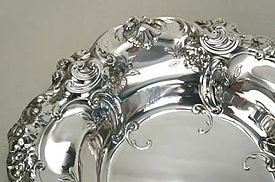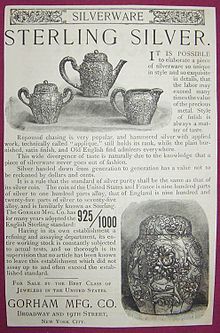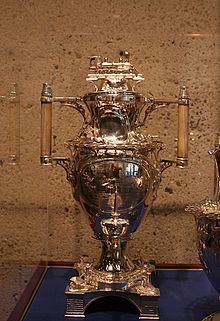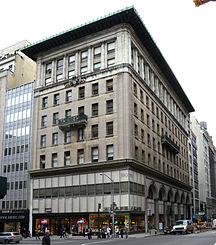- Gorham Manufacturing Company
-
The Gorham Manufacturing Company is an American manufacturer of sterling and silverplate.
Contents
History
Gorham Silver was founded in Providence, Rhode Island 1831 by Jabez Gorham,[1] a master craftsman, in partnership with Henry L. Webster.[2] The firm's chief product was spoons of coin silver. The company also made thimbles, combs, jewelry, and other small items. In 1842, a tariff which effectively blocked the importation of silverware from outside the United States was passed, which aided the American silver industry. Jabez Gorham did not take full advantage of this opportunity, but in 1847 Jabez retired and his son, John Gorham[3] succeeded him as head of the company. John Gorham introduced mechanized production methods, enlarged the premises in downtown Providence, improved the designs, and expanded the product line. In 1852 Gorham toured many of Europe's silver workshops and manufacturers, speaking with individual specialists, including master craftsmen and toolmakers. He also sought out highly skilled foreign workmen to train his American workers. George Wilkinson, a premier designer and workshop manager, was hired from England. In 1865 a charter was granted by the Rhode Island legislature by the name of "Gorham Manufacturing Company". In 1890 the company relocated to a factory on Adelaide Avenue in Providence.
During the heyday of American silver manufacturing, approximately 1850 - 1940, Gorham was highly influential. William C. Codman, one of Gorham's most noted designers, created Chantilly in 1895, which has become the most famous of Gorham's flatware patterns. Matching holloware has been made in both sterling and silverplate.
In 1884, the company opened a store in the Ladies' Mile shopping district in Manhattan, New York City, but moved in 1905 to a Fifth Avenue building which was designed for the by Stanford White. In 1906 Gorham purchased another long-time rival, Kerr & Co, which was based in New Jersey.
The company was purchased by Textron in 1967, a move that some critics claim decreased quality due to management's lack of understanding of Gorham's specialty, producing high-quality sterling silverware and holloware.[4] Gorham was owned by Brown-Forman Corporation from 1991 to 2005 until it was sold to Department 56 in the Lenox holdings transaction.
Major commissions
The White House has used Gorham silver services during many administrations. Mary Todd Lincoln purchased an impressive tea and flatware service for use in the White House in 1859. The tea service was presented to the National Museum of American History in 1957.[5] Mrs. Ulysses S. Grant asked Gorham to commemorate the country's one-hundredth anniversary with a spectacular Century Vase that contained over 2,000 ounces of sterling silver, and a grand "loving cup" composed of 70,000 dimes was designed for Admiral George Dewey in 1899. The largest single commission Gorham ever received was the famous Furber service. Ordered by Colonel Henry Jewett Furber, the president of Universal Life Insurance Company of New York, the opulent 740-piece service represents Victorian era dining at its most elaborate. The monumental silver and parcel-gilt "Neptune" epergne made for Furber as part of this service was displayed at the Philadelphia Centennial Exposition in 1876. A large portion of the service now can be viewed at the Rhode Island School of Design[6] as part of its exhibit on American decorative arts. The George W. Bush family chose Gorham's Chantilly as the flatware service on Air Force One.
Gorham artisans also sculpted the famous monument of George Washington in the Capitol's Rotunda, the statue of Theodore Roosevelt that overlooks the Museum of Natural History in New York, and the famous "Independent Man" which tops Rhode Island's state house.
Gorham designed a number of elaborate trophies for sporting events, including the Borg-Warner Trophy for the Indianapolis 500, designed by Robert J. Hill.
European recognition
In 1886 a commentator wrote in the London Magazine of Art:
If we go to one of the first London silversmiths and ask for spoons and forks, we are met at once with the smiling query. "Yes, Sir; fiddle or old English?" Fiddle or old English! If we decline both those chaste designs we are assured that there is still a large selection of patterns remaining. The "Lily", the "Beaded", "King's Pattern", and "Queen's Pattern." There perforce, our choice must end....Mark the difference, in this one article, between the supine conservatism of the English manufacturers and the alertness and constant progress of the American maker. For instance [Gorham] would not be satisfied unless it produced every year or two new patterns, nearly all of which are beautiful, and of which they will produce a complete service of all articles for table use from a salt-spoon to a soup ladle.
In 1893 a French observer was surprised by America's "remarkable fertility in the variety of its patterns for table services." Of the flatware patterns designed by F. A. Heller (1839–1904) for Gorham he wrote "we have no idea of the richness of ornamentation of these services, and of the amount of talent expended by him in the engraving of the dies which he has made on the other side of the Atlantic."[7]
Buildings
Two buildings connected with the Gorham Manufacturing Company have historical status:
- Gorham Manufacturing Company Building
This Queen Anne style building located at 889-891 Broadway at the corner of East 19th Street in the Flatiron District of Manhattan, New York City, within the Ladies' Mile Historic District, was designed by Edward Hale Kendall and built in 1883-1884 as the retail store of the company. At first, the company utilized the two bottom floors and the rest were rented as bachelor apartments, but after a few years Gorham expanded into the rest of the building. The company left in 1905, and the building was converted by John H. Duncan in 1912 into lofts and offices, removing a corner tower and adding roof dormers. In 1977, it was reconverted back to its original configuration, with the ground floor a retail store, and the remaining floors made into cooperative apartments. The building was designated a New York City landmark on June 19, 1984.[8][9][10]
- Gorham Building
When the company left their Ladies' Mile building, it was to move to this Italian Renaissance Revival palazzo-style building at 390 Fifth Avenue at West 36th Street in the Murray Hill neighborhood. Designed by McKim, Mead & White, with Stanford White as the partner in charge, and built in 1904-1906, the building features bronze balconies and friezes designed by Gorham's staff, and is topped by a cooper cornice. It was designated a New York City landmark on December 15, 1998, but not before the lower floors were significantly altered from their original design.[11][12]
References
- Notes
- ^ http://freepages.genealogy.rootsweb.com/~silversmiths/makers/silversmiths/28414.htm
- ^ http://freepages.genealogy.rootsweb.com/~silversmiths/makers/silversmiths/28018.htm
- ^ http://freepages.genealogy.rootsweb.com/~silversmiths/makers/silversmiths/49021.htm
- ^ Lost Luster
- ^ http://www.150.si.edu/150trav/remember/r215a.htm
- ^ http://208.249.124.198/museum_press_14.htm
- ^ Translation of the French from M. Camille Krantz, International Exposition of Chicago, 1893 (Paris, 1894), pp. 4-5
- ^ New York City Landmarks Preservation Commission. Guide to New York City Landmarks (4th ed.) New York:Wiley, 2009. ISBN 978-0-470-28963-1, p.76
- ^ Mendelsohn, Joyce. Touring the Flatiron. New York: New York Landmarks Conservancy, 1998. ISBN 0-964-7061-2-1, pp.95-96
- ^ White, Norval & Willensky, Elliot (2000). AIA Guide to New York City (4th ed.). New York: Three Rivers Press. ISBN 0812931076., p.195
- ^ New York City Landmarks Preservation Commission. Guide to New York City Landmarks (4th ed.) New York:Wiley, 2009. ISBN 978-0-470-28963-1, p.99
- ^ White, Norval & Willensky, Elliot (2000). AIA Guide to New York City (4th ed.). New York: Three Rivers Press. ISBN 0812931076., p.227
- Bibliography
- "Silver in America, 1840-1940" - Magazine Antiques, December 1994 by Charles L. Venable
- Gorham Silver, 1831-1981 - N.Y., Dodd, Mead, 1983, by Charles H. Carpenter
External links
Categories:- American silversmiths
- Manufacturing companies based in Rhode Island
- Landmarks in Manhattan
- Buildings and structures completed in 1884
- Queen Anne architecture in New York
- Buildings and structures completed in 1906
- Italian Renaissance Revival architecture in the United States
- McKim, Mead, and White buildings
- Office buildings in Manhattan
- Ceramics manufacturers of the United States
Wikimedia Foundation. 2010.





